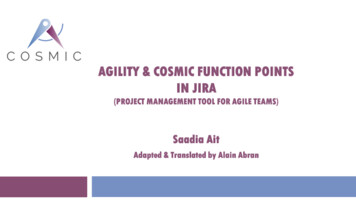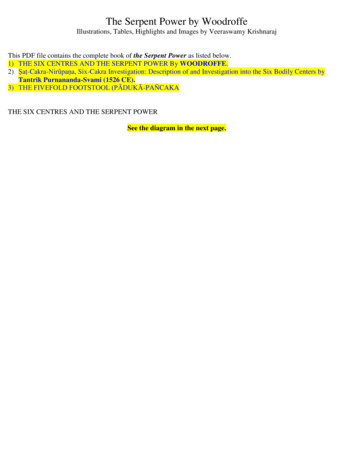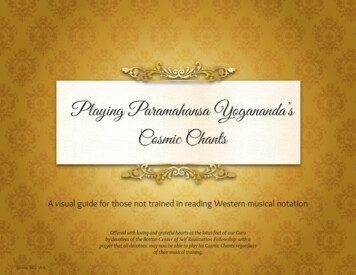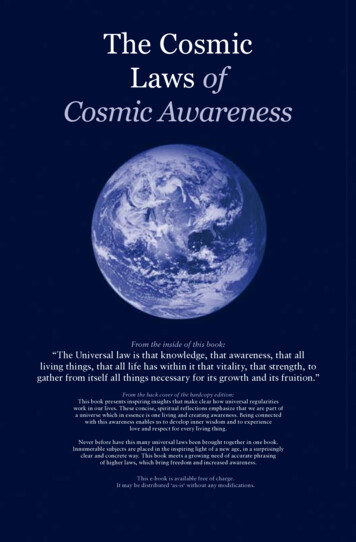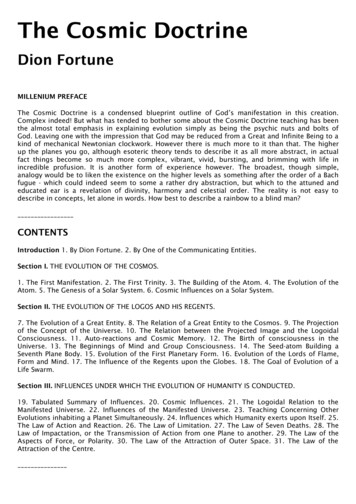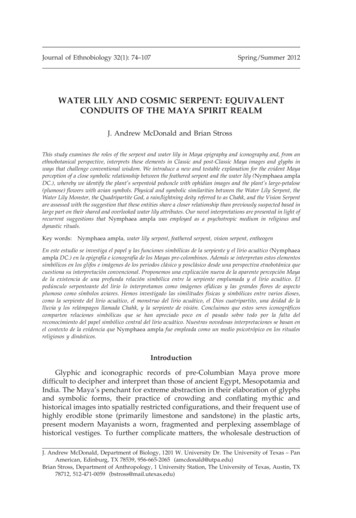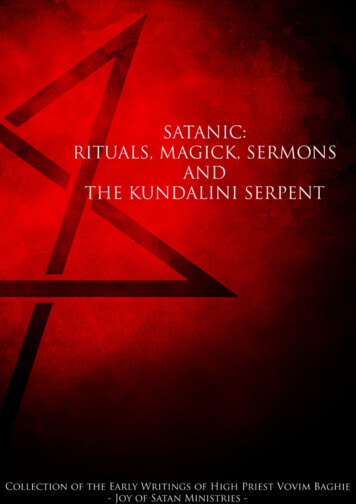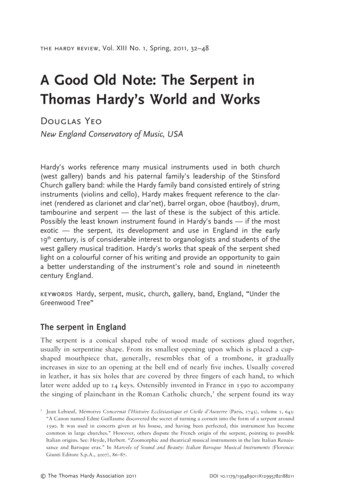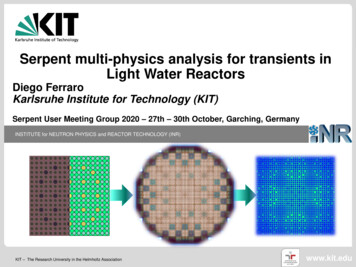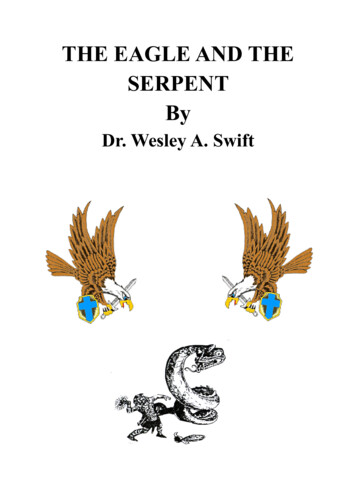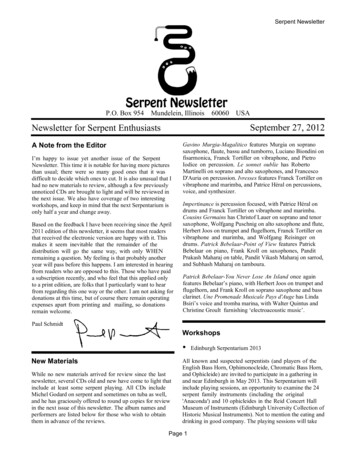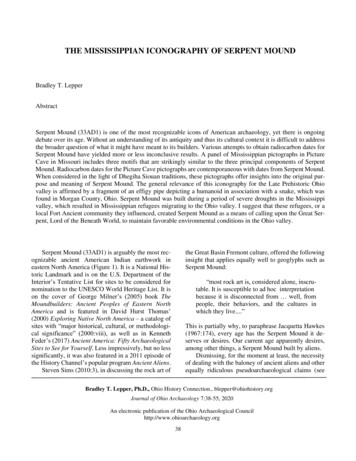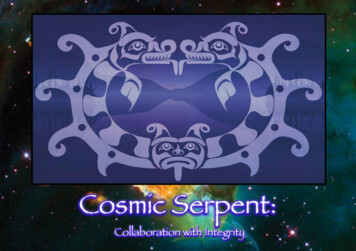
Transcription
Cosmic Serpent:Collaboration with Integrity
Supernova Remnant fromNASA’s Spitzer / WISE Space TelescopesCosmic Serpent image on the cover designed by and used withpermission by Daniel K. Smith (Gwadaxa)
Nā Koa MoʻoNative Hawaiian Warrior Chant written for theCosmic Serpent ProjectHe mai, he heahea, he ohooho!A call, a welcome, an acclaimation!E nā moo o ka lewa lani, nā moo o ke kai ulinā moo o ke ao, nā moo o ka pōnā moo o ka pāpapa, nā moo o ke kualononā moo o nā mokuhonua, nā moo o nā mokupuninā moo o ka wao one, nā moo o ka ōnaeao ēOh serpents of the multiple heavens, of the deep seaof the dark of night, of the light of day,of the shoals and reefs, of the mountain ridgesof the continents, of the islandsof the deserts and plains, oh serpents of the universeE hō mai ka ike, e hō mai ka mana, e hō mai ke aloha ēI hā, i eaea, i ola loa nō ēE nenee mai, e pili mai,E kōkua mai i ou mau koa, i ou mau keikiGrant us knowledge, grant us strength, grant us loveBreath into us life, a long life indeedMove close, cleave to us,Give aid to your warriors, to your childrenImua e nā koa o ka mauli ola, i ola mau nā loina o nā kūpunai ka wai ike, i ka wai puna, i ka wai ola, e kena ai ka puu ēForward, warriors of Indigenous essence so the customs of ourancestors will live in the waters of knowledge and life our thirst willbe quenchedKaimanaonālani BarcarseE ola nā moo, he moolelo, he mookūpuna, he mookiinahe mooakua, o ka moolewalipo ēLife to the serpents, the story, the genealogy, the processes,the godly ceremonies, indeed life to the cosmic serpent!E lele, e kolo, e au, e pii, e holo, e kaua no ka pono ōiwiFly, crawl, swim, climb, run, go forth and fight for our Native waysna D.N. Kaimanaonālani Barcarse24-25.I.2011, Ma ke kulu aumoe,me ke kā a Makalii ma ka lolopua
The Cosmic SerpentBridging Native Ways of Knowing andWestern Science in Museum Settings.A Collaboration between the Indigenous Education Institute and theUniversity of California, Berkeley’s Center for Science Education at the Space Sciences Laboratory,funded by the National Science Foundation.Authors: Nancy C. Maryboy, Ph.D., David Begay, Ph.D., Laura Peticolas, Ph.D.Evaluator Authors: Jill Stein and Shelly Valdez, Ph.D.Editor / Layout / Graphic Design: Christopher S. TerenEditing: Karin Hauck, Ruth Paglierani, and Renee FrappierGraphic Design: Ashley C. TerenNational Science Foundation GrantDRL-0714631 & DRL-0714629Copyright 2012Indigenous Education Institute
Dedication:In memory of Angayuqaq Oscar Kawagley, Ph.D. (1934-2011) whocontributed so much to our path of knowing.“.The cry of the raven is encouraging us to balance our physical,emotional, intellectual, and spiritual selves, and to walk peacefully aswe extend our ways to others and in our own Native languages.”Piurciqukut yuluta pitaliketuluta “We will become people living a life that feels just right.Quyana!”Acknowledgement and gratitude to Angayuqaq Oscar Kawagley and Ray Barnhardtwho have demonstrated and lived collaboration with integrity.“The depth of Indigenous knowledge rooted in the long inhabitation of a particular place offerslessons that can benefit everyone, from educator to scientist, as we search for a more satisfying andsustainable way to live on this planet.”—Angayuqaq Oscar Kawagley, Ph.D. and Ray Barnhardt, Ph.D.
Table of ContentsEast: Ha’a’aah - Place of Initiation(Nitsáhákees)Section 1: The Cosmic Serpent: A Global ArchetypeSection 2: The Diné Cosmic ModelSection 3: Gaining Awareness of WorldviewsSection 4: Similarities with Western ScienceResources14161826South: Shádi’ááh - Place of Organization & Growth(Nahat’á)Section 5: Building RelationshipsSection 6: Developing the ProcessSection 7: Pilot WorkshopSection 8: Restructure Workshops30323436West: I’i’aah - Process of Activation - Living It.(Ii’ná)Section 9: Southwest WorkshopsSection 10: Northwest WorkshopsSection 11: California WorkshopsSection 12: Culminating Conference38424854North: Náhookos - Process of Transformationand Renewal (Siihasin)Section 13: TransformationSection 14: RenewalSection 15: Evaluation / OutcomesSection 16: SustainabilityAdvisors 95Cosmic Serpent Fellows96Participating Institutions98ContributorsPeople who contributed to this bookCosmic Serpent Team LeadershipRefrences and Resources100101103CreditsPhotographs, Illustrations108AcknowledgmentsA Special Thank You To.62687088The Cosmic Serpent Project’s website can be found at http://cosmicserpent.org109
Diné Cosmic Model Table of Contents - Process ModelThis diagram illustrates the cyclicalorder of sections in the bookSection 1Section 4Section 2Section 3Section 5Section 13Section 14Section 16Section 15Section 7Section 9Section 12Section 10Section 116Section 6Section 8This book has been conceived in a sunwise (clockwise) directionalmovement, with major emphasis on process and relationships, inaccordance with traditional Diné cyclical ways of knowing. The cyclicalprocess provides the intrinsic conceptualization and contextualizationof the book, being flexible and multi-dimensional, connoting a nonhierarchical order of interrelationships. We provide a linear processoverview in our next section in order to show a linkage between theIndigenous cyclical and Western linear organization. We hope this linkagewill serve various populations of our readers - as some will relate to thecyclical process and some to the linear process.
Diné Cosmic Model Table of Contents - Process Model with Section TitlesIntroduction:Ignitingthe sparkThis diagram illustrates the interrelationships of section titles in the book.The sun-like symbol illustrates an ignitingforce, which begins the process. In thisbook, the igniter is the introduction.Igniting the spark.TheCosmic Serpent:A GlobalArchetypeSimilaritieswith WesternScienceThe DinéCosmic ModelGainingawareness hopsEvaluation /OutcomesDevelopingthe ProcessPilot els courtesy of Indigenous Education Institute.Maryboy / Begay 2011NorthwestWorkshopsCaliforniaWorkshops7
Introduction: Igniting the Spark – Who, Why and WhereforeSetting the StageThis book is a deliverable (requisite) of an NSF (National Science Foundation) grant to share theproject outcomes and what we learned from the NSF grant project. This four-year NSFproject was funded to provide professional development to museum educatorsabout Indigenous Knowledge and Western Science in museums, with thegoal of providing a culturally relevant way for Indigenous communities toconnect to science. The name of this grant was “Cosmic Serpent: BridgingNative Ways of Knowing and Western Science in Museum Settings.”This book is also a snapshot in time of this work in IndigenousKnowledge and Western Science in museums. That is, this book isa written document that describes our understandings of thesescience education concepts today, built on work done in thepast, and constantly evolving with continued research into thefuture. It is within this context that we provide a bit of historyof how this NSF project came to be.The seed for this work was planted, so-to-speak, manyyears ago with the collaboration between an astronomer/science educator at UCB (University of California, Berkeley),Dr. Isabel Hawkins, and a Cherokee-Navajo astronomer/science educator from IEI (Indigenous Education Institute),Dr. Nancy Maryboy. After years of working together, and withothers, around the ideas of cultural relevance of science toIndigenous communities, they began to work to obtain NSFfunding to develop professional development workshops forinformal educators to sustain the work they had begun. One bookthat inspired Nancy and Isabel at this stage was “Cosmic Serpent” byJeremy Narby. Dr. David Begay, Navajo astronomer/science educator atIEI, joined the team to develop the proposal for the project. Isabel, Nancy,and David then collaborated with Dr. Mary Marcussen (Marcussen & Associates)to help focus the envisioned project on the most important science educationresearch and best practices in the ISE (Informal Science Education) field. The ISE field is inthe field of study that understands how we learn outside of the classroom.8
Ms. Ruth Paglierani, science educator at UCB, also joined the team, with a wealth of experience envisioning and implementing science educationprograms. David and Nancy had worked for years with their own Cherokee and Navajo (Diné) communities in science and science education. Ruthand Isabel had collaborated for years on science education work around the world. The collaboration between Nancy, David, Isabel, and Ruth madefor a strong and robust partnership that had been built over time. Throughout the proposal process and the project itself, our program officer atNSF (National Science Foundation), Dr. Sylvia James, helped the Cosmic Serpent team to understand the goals of NSF and how this project couldsupport those goals.The collaborative project was funded in 2007 with Dr. Nancy Maryboy as overall PI (Principal Investigator). Dr. Isabel Hawkins and Dr. David Begaywere Co-Principal Investigators (Co-PIs) and Ruth Paglierani was Project Manager. Dr. Martin Storksdieck was the lead evaluator of the project fromILI (Institute for Learning Innovation), and together with Jill Stein, also of ILI, and Dr. Shelly Valdez, of Native Pathways, made up the evaluation team.Wendy Pollock was the education partner from the ASTC (Association for Science and Technology Centers) and Pam Woodis was the educationpartner from the NMAI (National Museum of the American Indian).After the work was funded, the partnerships that developed during the writing of the proposal continued, but several specific individuals movedto other things, while other individuals joined the team. In the second year of the project (2008), Isabel retired from her position at UCB. Dr. LauraPeticolas, space scientist and educator, who had worked in Isabel’s group for five years and had collaborated with Isabel on many projects, tookover Isabel’s role as Co-Lead on Cosmic Serpent. Laura had never before worked with Nancy and David. While working to accomplish the goals ofthe project, it took about a year to develop a strong collaboration with solid communication between this new leadership. Renee Frappier, at UCB,took on the role as project manager with Ruth supporting the leadership team in design of the professional development workshops. Ashley Terencame on board as project manager with IEI. Around this same time, Dr. Martin Storksdieck moved to work at the National Academies of Science on“A Framework for K-12 Science Education: Practices, Crosscutting Concepts, and Core Ideas” (NRC, 2011) Jill Stein and Dr. Shelly Valdez remainedas evaluators on the project but took over the evaluation lead as a collaborative team. Dr. Eric Jones joined the evaluation team. Wendy Pollockmoved to other projects and Laura Huerta-Migus took on the ASTC - partner role. Over the years of the project, this Cosmic Serpent team becamea strong collaboration between all ten individuals who represented six different institutions from science education and Indigenous communities.9
A Direct, Explicit, and Linear Explanation of this BookThis book was written in a collaborative manner, modeling the way in which the NSF (National Science Foundation) Cosmic Serpent project wasdeveloped and carried out. That is, the book was written with leadership from Dr. Nancy C. Maryboy, Dr. David Begay, and Dr. Laura Peticolas as acollaborative team working closely together. It was written with strong input from Ruth Paglierani, Dr. Isabel Hawkins, Renee Frappier, and AshleyTeren. Jill Stein, Dr. Shelly Valdez, and Dr. Eric Jones provided the voice, not only of the Cosmic Serpent Fellows, the participants of the workshops, butalso of Western Evaluation thought (Jill and Eric) and Indigenous Evaluation processes (Shelly). In this book, the Cosmic Serpent Fellows share theirviews on the project directly through quotes of their own, through the evaluation, and indirectly through conversations with the Cosmic Serpentteam. The Cosmic Serpent Fellows are the heart of this project – they are the people who participated in the professional development workshops,bringing their knowledge and perspectives with them and taking back what they learned to their museums. The book also contains the voice of thecommunity of American Indians through Pam Woodis (National Museum of American Indian, NMAI) and Laura Huerta-Migus (Association of Science- Technology Centers, ASTC) who provides the voice of America’s science centers and museums. Ashley Teren provided graphics and captions to thephotographs. Traci Walter provided support in ensuring we had permission to use the photographs and in gathering the resources and citations.Christopher Teren was the main designer and editor of the layout of the book, and contributed graphics.Karin Hauck of UCB (University of California, Berkeley) worked with Christopher Teren and the team on editing and layout. Dr. Bryan Mendez (of UCB)and Dr. Mary Marcussen reviewed the initial draft of the book and provided comments. Because this book was written in a collaborative fashion, inputfrom all of these voices are interwoven throughout this book. We further acknowledge with gratitude all who helped to develop and implement thisproject and the project deliverables towards the ‘end’ of this book.The intent of this book is to share our Cosmic Serpent project and highlight significant outcomes. This book has been written for the broadest audiencepossible. For the American public, we hope this book provides valuable informationthat may inspire all people to learn more about science and how it relates totheir own culture; For educators who work with science museums, tribal museums, culturalmuseums and the diversity of the public who visit museums, we hope thisbook provides valuable lessons from our project on how to collaboratewith integrity and connect with Native people, and that it provides ideas forconnecting with the diversity of cultures in the United States around scienceand knowing;10
For Native Americans and other Indigenous people, we hopethis book demonstrates how Native Ways of Knowing can bebrought with mutual respect to the science community andhow science could be a useful tool to enhance Native waysof knowing For scientists, we hope this project provides an awarenessof Indigenous ways of knowing and guidance to those whowould like to collaborate with Indigenous Knowledge holdersto better understand the complexity and interrelationshipsof the world and universe in which we live.We attempted to create a book that was not limited to aparticular sector of the public, with as little text as possible andas many images and photographs as possible. We hope thatthis book is both read by the layperson as well as those in theprofessional informal science education field.Western Science: We use this term throughout this book and the Cosmic Serpentproject because the cross-cultural collaborations require us to put science into acultural context. Using “Western Science” instead of “science” is a reminder thatwhat we call science today has its origins in Western, or Eurocentric, cultures.The term Western Science conveys that the science of which we speak includesthe Western European cultural ways of understanding nature and the universe.In the Cosmic Serpent project these cultural ways of understanding nature arejuxtaposed with Native or Indigenous ways of understanding nature.Native Science, Indigenous Knowledge and Native Ways of Knowing: We use theseterms throughout this book, somewhat interchangeably. We often use “ways ofknowing”, because knowledge can imply a static body of information. “Ways”of knowing reminds us that there is more than one way of knowing. “Knowing”reminds us that our knowledge is a dynamic, ever-moving process. “NativeScience” is sometimes used to remind us that the word “science” originates fromthe concept of knowing.For more information on the reasons for using this terminology, please seeMaryboy & Begay, 1998 and “Bridging Cultures: Indigenous and Scientific Ways ofKnowing Nature” (Aikenhead and Michell, 2011)There are many challenges in writing a book such as this. Thisbook was designed and organized to be accessed in at least twodifferent ways. In one way, it can be approached as a cyclical and holistic document, coming back to certain important ideas again and again. This isa complex model whose nature is reflected in its cyclic and fractal nature, as it uses the Diné Cosmic Model as a structure (Maryboy & Begay, 1998).It was written to honor the Cosmic Serpent project model, of having the Indigenous voice lead the project, but allowing access to the work by allreaders. This book can also be approached in a linear fashion, with concepts building on one another as they are introduced throughout the bookand then, finally, expanding on them on toward the end. In both approaches, we designed the document to be read in its entirety, to be absorbedas a complete work. We imagine readers engaging with it actively and completely, including perhaps even “talking back to it” or “discussing withit”. We have found from reviewers, that this book brings up many different emotions and we urge our readers to engage with those emotions andthe Cosmic Serpent content as much as possible, as this indicates to us a true learning process.Linear Site-Map of BookNext we provide a linear “roadmap” to the book for our readers who would like to understand where they might find certain topics or informationwithin the book. We hope this will allow such readers to jump to the section relevant to their own inquiry about this Cosmic Serpent project.11
This introduction starts in ‘igniting’ the book’s cyclical process. The main sections of the book are organized according to the Diné Cosmic Model (Maryboy & Begay, 1998). The chapter and section titles of thebook are presented in this holistic Diné Cosmic Model circular graphic on pages VIII-IX in order to show the inter-relatedness of every section. Ifwe were not limited by the linear and two-dimensionality of a book, we could perhaps present the connections between sections and ideas moreeasily. But we have done the best we can within the construct of a book. In Chapter “East: Ha’a’aah - Place of Initiation (Nitsáhákees)”, we present the beginnings of the project, including 1) the Cosmic Serpent DinéCosmic Model that includes the project goals and objectives, 2) the reason for the name of this project “Cosmic Serpent”, 3) thoughts on the team’scollaboration at this early stage of the project and 4) a glimpse into commonalities and differences in Indigenous ways of knowing and scientificprocess with many references at the end to learn more. In Chapter “South: Shádi’ááh - Place of Organization & Growth (Nahat’á)”, we present the process by which we began the work to provide professionaldevelopment workshops to science center, tribal museum, and cultural museum practitioners. We describe our first pilot workshop and the findingsfrom this first workshop. Written documents such as this book are helpful; however we demonstrate and stress the importance of learning thiscontent by way of cross-cultural partnerships that first and foremost require ample time to develop as well as significant face-to-face time. In Chapter “West: I’i’aah - Process of Activation - Living It.(Ii’ná)”, we present information about the six week-long professional developmentworkshops we hosted during 3 years of the project. As our entire project was built around in-person meetings, we dedicate a large part of thisbook towards describing the workshops and highlighting different tools and approaches within the agendas, which were especially effective. Inthese workshops, as with this book, we have emphasized the Indigenous worldview as this is not taught in mainstream culture, whereas science is.We had and have to find the balance between these two worldviews, by spending more time creating awareness of Native ways of knowing. In Chapter “North: Náhookos - Process of Transformation and Renewal (Siihasin)”, we share out the results of this project in terms of collaborationsthat took place and public experiences that were created in part due to the Cosmic Serpent workshops. We also present what we have learnedfrom this project both as leaders of the project as well as from our evaluation team. We provide evidence on how sustainability of this work is builtinto the process of relationship. Through Cosmic Serpent Fellows’ partnerships between Cosmic Serpent Fellows, projects at museums involvingWestern Science and Native Ways of Knowing are just now sprouting up around the Western United States. Throughout the document we bring the voices of the Cosmic Serpent Fellows, the participants of our workshops, into this book via actual quotes.The Cosmic Serpent Fellows are the focus of the project and the central driving force that allowed us to create this book. They are the hope andinspiration for the sustainability and dissemination of programs and products that value and present Native Ways of Knowing – the knowledgeof nature brought about by observations and data by people and the natural system developed by thousands of years of living in one place –together with the abstracted and generalized knowledge of Western science based on observation and data often collected by sophisticatedmodern technology. In the later pages of the book, we acknowledge all the people who were a part of this project, from our NSF (National Science Foundation) projectmanager and our grant writer, to our team, the Cosmic Serpent Fellows and their institutions, and our advisors and presenters. Hundreds of peopletook part in this project and it was only because of so many people’s dedication that this project succeeded in the way that it did.12
Project OverviewThe Indigenous Education Institute and the UC Berkeley SpaceSciences Laboratory developed Cosmic Serpent, a professionaldevelopment project, to increase the capacity of museumpractitioners to bridge Native and Western science learning ininformal settings.Cosmic Serpent served 162 practitioners from 41 science centers/museums and 42 tribal/cultural museums and/or communities inthe U.S. Southwest, West, and Northwest (eight states). The intendedoutcomes of the project were to: 1) increase participants’ understandingof Native and Western science and awareness of the potentialities ofthe intersection of the two knowledge systems; 2) develop museumCosmic Serpent set out to explore commonalities between Western community programs that reflect these commonalities; 3) fosterand Native science, taking into account that Native cultures have, enduring and respectful partnerships between museums and Nativeover millennia, developed ways of knowing that are highly adapted, communities; and 4) increase institutional capacity to engage Nativeinterconnected, and enduring. Each knowledge system informs the audiences in science.practice of science and its role in society in a fundamental way, andthe commonalities can provide a framework for developing mutually Evaluation conducted by the Institute for Learning Innovation and Nativeinclusive learning experiences in STEM (science, technology, engineering, Pathways tracked participant outcomes and the potential for broaderand mathematics).sustainable impact on their institutions. The project incorporated anew approach towardevaluation,onethat embraces jointProfessional development workshops and peer mentoringinterpretation of dataMuseum programs featuring Native/Western commonalities as by teams with differentyetcomplementaryentry points to STEMevaluation approachesRegional partnerships among museums and Native communities (informalscienceevaluationandMultimedia resourcesIndigenous evaluation),A legacy document to inform the ISE field on ways to improve and that models thetype of cross-culturalSTEM programming for Native AmericanscollaborationthatA culminating conference jointly hosted by NMAI (National the project itself isMuseum of the American Indian) and ASTC (Association of Science designed to support.& Technology Centers). The project was guided and sustained byNative and Western scholars experienced in bridging Native waysof knowing and Western science. This book serves as the ‘legacydocument’ mentioned as Deliverable 5.Deliverables included: Susan Sheopships from Tamástslikt CulturalInstitute at the Fairbanks Workshop13
East: Ha’a’aah - Place of InitiationSection 1 . The Cosmic Serpent: A Global ArchetypeThe Cosmic Serpent is a trans-cultural icon. It is a global symbol that highlights the interconnected nature of fundamental concepts inearth, space, life and environmental sciences.Around the world, for thousands of years, in one form or another, the reptilian serpent (snake, dragon, Naga - of Hindu tradition, the NativeHawaiian mo’o) has been an archetype for countless tribes, societies and civilizations. In almost every instance, the serpent stands for immenseand powerful cosmic movements. This is true of archetypal serpents deep under the earth, deep under the oceans, on the earth surface and in thesky. In fact, it is the very ability of serpents to move between various worlds and different dimensions which give them a significance, providingpurpose and direction to ways of knowing and being, world-wide. Other physical and transformational qualities of serpents, such as the sheddingof their skins symbolizing regeneration, add to their complex, mutable characteristics, illustrating the awe with which they are regarded.Indigenous cultures around the world use cultural lore in the form of story to teach important lessons applicable to life. Many of these stories, oftentermed “myth” have foundational representations of the natural world, including the human connection and human participation in the place inwhich they live. Sometimes the cosmic serpent is viewed as representative of negative energy, sometimes as positive and sometimes as providingbalance and/or ambivalence.Australian Aboriginal woodcarving.14
Double-headed serpents are seen in some of the rock carvings ofPacific Northwest Coast tribes. These carvings are found in specificplaces where geologists are now finding that massive earthquakestook place. In Guatemala researchers are finding links betweentraditional serpent stories and large landslides and earthquakes. InAustralia, Aboriginal stories from knowledge going back more than40,000 years, tell of Rainbow serpents guarding pure water holes andunderground aquifers, in the world’s driest continent.The Cosmic Serpent archetype as it pervades many different culturesseems to speak to the idea that our diverse cultures have many thingsin common. As Indigenous scholar Phillip Duran says, “the archetypehas a specific meaning within each culture, yet as a global symbolit helps to convey the message that all cultures are interconnectedby virtue of their humanity and, more specifically, it conveys whatthe project hopes to accomplish, which is to build bridges betweenWestern and Native world views.”We have chosen the archetype of the Cosmic Serpent to identify thisproject. This is truly one symbol that can speak to the interconnections,relationships and processes of many cultures, and is illustratedthrough centuries of art, music, song, observation, and science.15
East: Ha’a’aah - Place of InitiationSection 2 . The Diné Cosmic ModelNitsáhákees(East)East - Ha’a’aahA place of initiation.SiihasinPractitioners will gainappreciation of a Native worldview that hascommonalities withWestern Science.Nahat’á(North)(South)North - NáhookósIiná(West)We used these directions to navigateour own path through this project.16Cosmic Serpentnamed for a transcultural symbolA place of transformation,renewal, and evaluation leading connected to science concepts, willhelp bridge Indigenous and Westernto sustainability. Practitionersscience, and will help museumsand institutions will engage inengage Native audiences andscience in culturally responsiverepresent Indigenousways.perspectives.West - I’i’aahA place of activation.Museum practitioners willinfuse both traditionalknowledge andWestern science into theirprogramming.South - Shádi’ááhA place of growthand organization.Practitioners will buildrelationships with museumpeers, tribal communitymembers, and people withknowledge of bothIndigenous and Westernscience.
The Cosmic Serpent project used an Indigenous-based strategic planningmodel to organize itself. The four strategic goals written into the CosmicSerpent project were based on the tenets and planning principles ofthis Indigenous-based strategic planning model. This process modelwas developed from observation of the natural cosmic order, andusing the natural processes created by the natural order to provideorganization and structure. Relevant strategic planning principles andtenets extracted from the observable natural order were utilized for theplanning and evaluation of the Cosmic Serpent project. This planningmodel was developed from the cultural songs and stories of the Navajo(Diné) that have been shared and passed down for countless generationsin the American Southwest. In essence, the model and its processes,organization and structure are replicated from the natural cosmic order.Nature provides the planning model, organization, processes, andstructure.order, and structure.This model is dynamic, and can be adapted to multiple uses dependingon unique organizational and planning needs. We have used the fourseasons, and four cardinal directions, organized into quadrants, usingthe four colors of the sky in the natural order as perceived by the Dinépeople: pre-dawn (white), midday (blue), evening twilight (yellow),darkness (black). The process illustrated in the mode
of the dark of night, of the light of day, of the shoals and reefs, of the mountain ridges of the continents, of the islands of the deserts and plains, oh serpents of the universe E hō mai ka ike, e hō mai ka mana, e hō mai ke aloha ē I hā, i eaea, i ola loa nō ē E nenee
